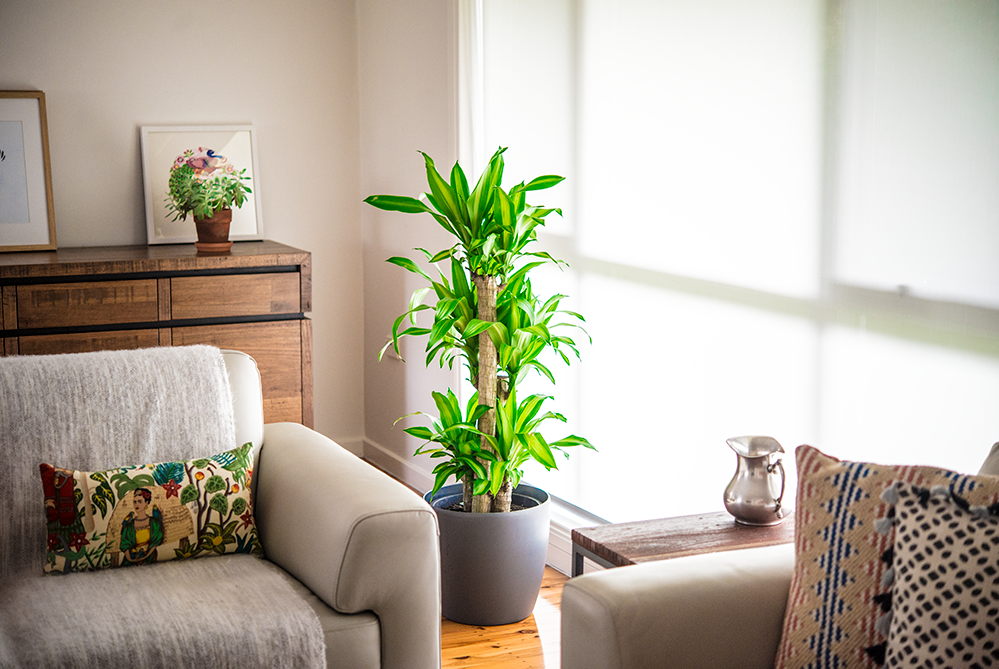Dracaena
Dracaena is a lush, tall, leafy plant that creates a tropical look indoors, on a balcony or in the garden. There are many species and cultivars that give a range of leaf colours and patterns. Some also have fragrant flowers.
Dracaena varieties
The most impressive dracaena variety is the dragon tree (Dracaena draco) (pictured above). This large, spreading, multi-branched tree resembles a gnarled palm with tufts of grey leaves. It grows slowly up to 9m high, spreads more than 3.5m wide and forms a stout, grey trunk. It is used as a feature tree in gardens, but can also be grown in large containers outdoors. Its common name is derived from its red sap, which resembles blood.
More commonly seen is the happy plant (D. fragrans), which has broad, strappy, glossy green leaves and is often grown as a handsome indoor plant. Happy plants grow to around 2-3m high and around 2m wide. Mature plants may produce fragrant yellow flowers.
There are many varieties of happy plant. ‘Massangeana’ has a white to light green stripe down the leaf centre and is often referred to as corn plant. Varieties in the Deremensis Group (often known as D. deremensis) have variegated leaves and may have red flowers. One of the most popular happy plants is ‘Janet Craig’, which is a vigorous plant with handsome green leaves. As it is vigorous even indoors it needs regular repotting. Prune to maintain its size and shape. For a contrast, grow it with ‘Lemon Lime’, a form of happy plant with lime and green striped leaves.
Also seen indoors or featuring in modern landscapes are forms of D. marginata including ‘Colorama’, which has strappy pink and green variegated leaves in a tuft from a single stem, and ‘Black Knight’, which has dark burgundy red-edged leaves. Plants branch with age and can be shaped with pruning. ‘Tricolor’ has striped cream, pink and green leaves.
Caring for dracaenas
Dracaenas originate in tropical and subtropical climates including Mauritius, West Africa and Madagascar. They need a warm, frost-free climate year-round to be grown successfully outdoors. Position most types of dracaena in a shaded or dappled light position (dragon tree tolerates full sun). Outdoors, dracaenas are often grown beside pools or in courtyards. Where winters are cold and frosty, grow them in containers, which can be moved to a frost-free winter position.
If growing indoors, select a warm, brightly-lit spot away from air-conditioners or heaters. In very dry indoor locations, mist foliage from time to time to increase humidity.
These plants often grow tall and lanky, but can be readily pruned by cutting back the top growth to encourage side branches. Prunings can be used as cuttings to grow new plants.
Water when dry, and fertilise garden plants at least once annually with a slow-release fertiliser. Plants that are indoors or in containers but are actively growing can be liquid fed occasionally.
Dracaena pests and problems
Common issues encountered on dracaenas grown indoors include scale and yellowing leaves. Pests and yellowing leaves indicate that the plant is stressed in its growing situation. Scale can be treated with horticultural spray oil but the plant should also be moved to a position with more light or warmth.
Yellowing leaves should be removed. Check watering as over or under watering can cause leaves to yellow as can a dry or draughty location indoors. Don’t allow plants to sit in saucers of water as the potting mix may become waterlogged, but potted plants can be placed on a bed of stones in water to increase humidity around the foliage.



